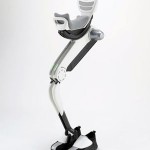Archive for Май, 2010
Экзоскелет для рабочих автомобильных конвейерных линий.
- Тип контента: Новостная статья
- Номер документа: 2513
- Название документа: Экзоскелет для рабочих автомобильных конвейерных линий.
- Номер (DOI, IBSN, Патент): Не заполнено
- Изобретатель/автор: Не заполнено
- Правопреемник/учебное заведение: Не заполнено
- Дата публикации документа: 2010-05-20
- Страна опубликовавшая документ: Россия
- Язык документа: Русский
- Наименование изделия: Не заполнено
- Источник: http://www.popmech.ru/article/7130-robot-nogi/
- Вложения: Не заполнено
- Аналитик: Ридна Украина)))
 Роботизированная система поддержки облегчит жизнь рабочим, вынужденным проводить долгое время в неудобном положении. На одном из заводов Honda она уже начинает использоваться.
Роботизированная система поддержки облегчит жизнь рабочим, вынужденным проводить долгое время в неудобном положении. На одном из заводов Honda она уже начинает использоваться.
Категория: Walking Assist Device | 1 Комментарий »
Motion-assist system of wearable motion-assist device, wearable motion-assist device, and motion-assist method of wearable motion-assist device
- Тип контента: Патент
- Номер документа: 4601
- Название документа: Motion-assist system of wearable motion-assist device, wearable motion-assist device, and motion-assist method of wearable motion-assist device
- Номер (DOI, IBSN, Патент): US2010/0121232A1
- Изобретатель/автор: Sankai, Y.
- Правопреемник/учебное заведение: Univ. of Tsukuba, Japan
- Дата публикации документа: 2010-05-13
- Страна опубликовавшая документ: США
- Язык документа: Английский
- Наименование изделия: Не заполнено
- Источник: http://www.google.com/patents/US20100121232
- Вложения: Да
- Аналитик: Дмитрий Соловьев
 In the present invention, the motion state of the wearable motion-assist device 10-1 of the doctor 1 is sent to the wearable motion-assist device 10-2 of the patient 2 via a network. Then, this motion state is applied to the wearable motion-assist device 10-2 of the patient 2, so that rehabilitation is conducted for the patient 2. Furthermore, the motion state of the wearable motion-assist device 10-2 of the patient 2 is sent from the wearable motion-assist device 10-2 to the wearable motion-assist device 10-1. Then, the motion state of the wearable motion-assist device 10-2 is applied to the wearable motion-assist device 10-1. Accordingly, the doctor 1 can objectively sense the state of the patient 2.
In the present invention, the motion state of the wearable motion-assist device 10-1 of the doctor 1 is sent to the wearable motion-assist device 10-2 of the patient 2 via a network. Then, this motion state is applied to the wearable motion-assist device 10-2 of the patient 2, so that rehabilitation is conducted for the patient 2. Furthermore, the motion state of the wearable motion-assist device 10-2 of the patient 2 is sent from the wearable motion-assist device 10-2 to the wearable motion-assist device 10-1. Then, the motion state of the wearable motion-assist device 10-2 is applied to the wearable motion-assist device 10-1. Accordingly, the doctor 1 can objectively sense the state of the patient 2.
Категория: Патенты | Нет комментариев »
Closed-Loop Control and Variable Constraint Mechanisms of a Hybrid Neuroprosthesis to Restore Gait After Spinal Cord Injury.
- Тип контента: Научная статья
- Номер документа: 9572
- Название документа: Closed-Loop Control and Variable Constraint Mechanisms of a Hybrid Neuroprosthesis to Restore Gait After Spinal Cord Injury.
- Номер (DOI, IBSN, Патент): Не заполнено
- Изобретатель/автор: CURTIS SAI-HAY TO
- Правопреемник/учебное заведение: Department of Biomedical Engineering CASE WESTERN RESERVE UNIVERSITY
- Дата публикации документа: Не заполнено
- Страна опубликовавшая документ: США
- Язык документа: Английский
- Наименование изделия: Не заполнено
- Источник: Не заполнено
- Вложения: Да
- Аналитик: Глаголева Елена
 A hybrid neuroprosthesis (HNP) was developed with the goal of providing improved gait to individuals with paraplegia relative to existing assistive gait systems. The HNP is an approach to restoring gait by combining a lower extremity exoskeleton with functional neuromuscular stimu-lation (FNS). Individually, exoskeletons apply constraints for support, but provide limited step length and depend on upper extremity actions on a walker for forward propulsion. Conversely, FNS mobilizes the limbs through electrical pulses to paralyzed muscles. However, muscles targeted for stimulation quickly fatigue and provide inadequate postural support. The HNP was designed to functionally combine the sup-portive features of the exoskeleton and joint mobility of FNS. Controllable knee and hip joint mechanisms were developed to support the user while allowing for functional motion from FNS for forward progression. These mechanisms were optimized for maximal torque when supporting a joint and minimal resistance when driven by FNS. A closed-loop controller based on sensor measurements of joint dynamics was developed to synchronize exoskeletal operation with muscle stimulus activity. The objectives were to modulate joint constraints to provide continual support to the user while minimizing the deleterious effects of the constraints on joint mobility, deactivate stimulus to target muscles when certain exoskeletal constraints are engaged to allow the target muscles to rest, and modulate FNS from baseline levels to achieve functi-onal joint positions. The operational response of the controller and mechanisms were characterized through simulation, bench, and able-bodied testing. Implementation of the HNP with an individual with paraplegia respectively showed a 40 % and 16 % reduction in maximum exerted upper extremity forces relative to exoskeleton-only and FNS-only gait. Step lengths were shown to be comparable between HNP and FNS-only gait. When comparing the HNP with and without the FNS modulation, the average gait speed was increased by 16 % with FNS modulation due to a 10 % increase in the hip range of motion. Reductions in muscle activity were feasible when the exoskeletal constraints were enabled. Future work to optimize joint coordination or apply an active mechanism to the exoskeleton to assist hip extension may improve postural control and forward progression.
A hybrid neuroprosthesis (HNP) was developed with the goal of providing improved gait to individuals with paraplegia relative to existing assistive gait systems. The HNP is an approach to restoring gait by combining a lower extremity exoskeleton with functional neuromuscular stimu-lation (FNS). Individually, exoskeletons apply constraints for support, but provide limited step length and depend on upper extremity actions on a walker for forward propulsion. Conversely, FNS mobilizes the limbs through electrical pulses to paralyzed muscles. However, muscles targeted for stimulation quickly fatigue and provide inadequate postural support. The HNP was designed to functionally combine the sup-portive features of the exoskeleton and joint mobility of FNS. Controllable knee and hip joint mechanisms were developed to support the user while allowing for functional motion from FNS for forward progression. These mechanisms were optimized for maximal torque when supporting a joint and minimal resistance when driven by FNS. A closed-loop controller based on sensor measurements of joint dynamics was developed to synchronize exoskeletal operation with muscle stimulus activity. The objectives were to modulate joint constraints to provide continual support to the user while minimizing the deleterious effects of the constraints on joint mobility, deactivate stimulus to target muscles when certain exoskeletal constraints are engaged to allow the target muscles to rest, and modulate FNS from baseline levels to achieve functi-onal joint positions. The operational response of the controller and mechanisms were characterized through simulation, bench, and able-bodied testing. Implementation of the HNP with an individual with paraplegia respectively showed a 40 % and 16 % reduction in maximum exerted upper extremity forces relative to exoskeleton-only and FNS-only gait. Step lengths were shown to be comparable between HNP and FNS-only gait. When comparing the HNP with and without the FNS modulation, the average gait speed was increased by 16 % with FNS modulation due to a 10 % increase in the hip range of motion. Reductions in muscle activity were feasible when the exoskeletal constraints were enabled. Future work to optimize joint coordination or apply an active mechanism to the exoskeleton to assist hip extension may improve postural control and forward progression.
Категория: Научные статьи | Нет комментариев »
Exoskeleton Enhancements for Marines: Tactical-level Technology for an Operational Consequence
- Тип контента: Научная статья
- Номер документа: 6599
- Название документа: Exoskeleton Enhancements for Marines: Tactical-level Technology for an Operational Consequence
- Номер (DOI, IBSN, Патент): Не заполнено
- Изобретатель/автор: Major C. Travis Reese
- Правопреемник/учебное заведение: United States Marine Corps School of Advanced Warfighting AY 09-10
- Дата публикации документа: 2010-05-04
- Страна опубликовавшая документ: США
- Язык документа: Английский
- Наименование изделия: Не заполнено
- Источник: FUTURE WARFARE PAPER
- Вложения: Да
- Аналитик: Глаголева Елена
 This monograph is presented to further a discussion that has persisted for decades, namely: Is it possible to reduce the weight of the combat load on the in-fantry soldier that will allow for nearly unimpeded speed and tempo in foot mobile operations? Since the mid-1990’s the Marine Corps has advanced future operating concepts that seek to achieve the promise of maneuver warfare, that is, the capability to maneuver against the weaknesses of an adversary so rapidly that they are unable to respond to the multiple threats presented across the battlefield, thus shattering their cohesion and decision making ability. An impediment to achieving this endstate has been the fact that foot mobile infantry forces are so overloaded with equipment that they have been unable to maneuver at the desired speed and with the desired distribution on the battlefield to achieve this maneuver effect. Through the ages three solutions have been attempted to reduce the load on the average infantryman: reduce the weight of equipment, transfer the load to some vehicle or beast of burden, and improve individual fitness and endurance. Even as the weight of individual components is decreasing, more pieces of equipment are being added to the combat load for communications, target acquisition, navigation, self protection, and night operating capability. Organizational loads are also increasing as infantry companies are now being given command and control responsibilities that were once reserved for a battalion or higher. There-fore, it is time to explore another alternative to weight mitigation that has never been tried before: wearable exoskeleton technology. The Marine Corps has acknowledged that not enough aviation or vehicles assets exist to move the force in the initial stages of a forcible entry operation, thus, the Marine Corps needs to provide every Marine with the capability to carry the load in the form of some wearable mechani-cal augmentation, which is what an exoskeleton provides.
This monograph is presented to further a discussion that has persisted for decades, namely: Is it possible to reduce the weight of the combat load on the in-fantry soldier that will allow for nearly unimpeded speed and tempo in foot mobile operations? Since the mid-1990’s the Marine Corps has advanced future operating concepts that seek to achieve the promise of maneuver warfare, that is, the capability to maneuver against the weaknesses of an adversary so rapidly that they are unable to respond to the multiple threats presented across the battlefield, thus shattering their cohesion and decision making ability. An impediment to achieving this endstate has been the fact that foot mobile infantry forces are so overloaded with equipment that they have been unable to maneuver at the desired speed and with the desired distribution on the battlefield to achieve this maneuver effect. Through the ages three solutions have been attempted to reduce the load on the average infantryman: reduce the weight of equipment, transfer the load to some vehicle or beast of burden, and improve individual fitness and endurance. Even as the weight of individual components is decreasing, more pieces of equipment are being added to the combat load for communications, target acquisition, navigation, self protection, and night operating capability. Organizational loads are also increasing as infantry companies are now being given command and control responsibilities that were once reserved for a battalion or higher. There-fore, it is time to explore another alternative to weight mitigation that has never been tried before: wearable exoskeleton technology. The Marine Corps has acknowledged that not enough aviation or vehicles assets exist to move the force in the initial stages of a forcible entry operation, thus, the Marine Corps needs to provide every Marine with the capability to carry the load in the form of some wearable mechani-cal augmentation, which is what an exoskeleton provides.
Категория: Научные статьи | Нет комментариев »
Применение Имплантируемых Микроэлектродов В Системах Управления Протезами
- Тип контента: Научная статья
- Номер документа: 7890
- Название документа: Применение Имплантируемых Микроэлектродов В Системах Управления Протезами
- Номер (DOI, IBSN, Патент): Не заполнено
- Изобретатель/автор: Д. Р. САФИН, И. С. ПИЛЬЩИКОВ, М. А. УРАКСЕЕВ, Р. М. МИГРАНОВА
- Правопреемник/учебное заведение: УГАТУ
- Дата публикации документа: 2010-05-03
- Страна опубликовавшая документ: Россия
- Язык документа: Русский
- Наименование изделия: Не заполнено
- Источник: Вестник УГАТУ Т. 14, № 2 ( 3 7 ) . С . 1 0 4 – 1 0 9
- Вложения: Да
- Аналитик: Глаголева Елена
 Статья посвящена обзору технических средств и методов регистрации электричес-ких сигналов с нервных волокон, возможных для применения в современных системах управления протезами. Авторами проведен сравнительный анализ различных конструкций имплантируемых микроэлектродов и материалов, из которых они изготавливаются, предложена классификация микроэлектродов. Рассмотрены основные проблемы регистра-ции нейросигналов и возможные пути их решения. Микроэлектродный массив; имплантируемый микроэлекртод; регис-трация нейросигнала
Статья посвящена обзору технических средств и методов регистрации электричес-ких сигналов с нервных волокон, возможных для применения в современных системах управления протезами. Авторами проведен сравнительный анализ различных конструкций имплантируемых микроэлектродов и материалов, из которых они изготавливаются, предложена классификация микроэлектродов. Рассмотрены основные проблемы регистра-ции нейросигналов и возможные пути их решения. Микроэлектродный массив; имплантируемый микроэлекртод; регис-трация нейросигнала
Категория: Научные статьи | Нет комментариев »
Статистика
Категорий: 179
Статей всего: 2,003
По типу:
Видео: 36
Выдержка с форума: 1
Контактные данные: 12
Научная статья: 1388
Не заполнено: 5
Новостная статья: 317
Обзор технологии: 42
Патент: 219
Тех.подробности: 34
Тип: 1
Комментариев: 6,230
Изображений: 3,005
Подробней...
ТОР 10 аналитиков
-
Глаголева Елена - 591
Дмитрий Соловьев - 459
Helix - 218
Ридна Украина))) - 85
Наталья Черкасова - 81
max-orduan - 29
Елена Токай - 15
Роман Михайлов - 9
Мансур Жигануров - 4
Дуванова Татьяна - 3
Календарь
Авторизация
Ошибка в тексте?
Выдели её мышкой!
И нажми Ctrl+Enter